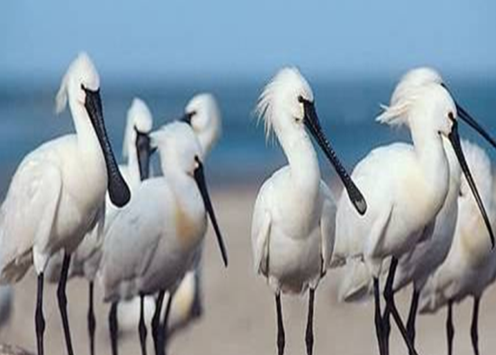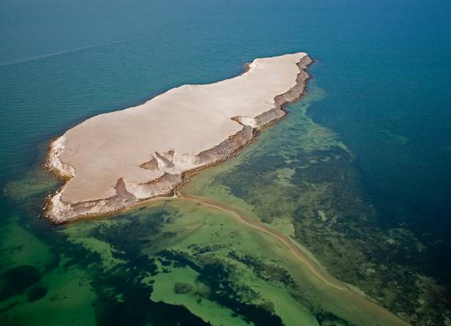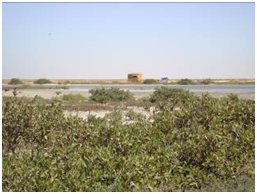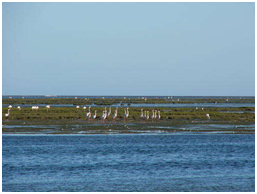Banc d'Arguin
(Year of inscription 1989; Site 506; Area 1,200,000 ha)

|

|

|

Benefits from WH designation:
Conservation of biodiversity
- the huge numbers of nesting and wading birds, and vast stretches of swamps and shallow coastal habitats, notably seagrass beds, have been protected and remain intact as a unique tropical ecosystem on the eastern shores of the Atlantic Ocean.-
Legislative and financial support for the site have been strong,
enabling establishment of a foundation (FIBA) for the site, negotiation of funds from the EU fishing agreement to establish a trust fund for the Park, and regular financing from tourism and economic activities associated with the park. Recognition of threats and action to mitigate them by the Mauritanian government
is illustrated by a raft of initiatives (e.g. oil spill, overfishing, and environmental impacts from hydrocarbon exploitation). The government, with support from FIBA and the WH Centre, recognises the economic importance of maintaining the integrity of the site for Mauritania.
Description
The Banc d'Arguin is one of the most important zones in the world for nesting birds and Palearctic migratory waders. It is a National Park (Parc National du Banc d'Arguin, PNBA) on the west coast of Mauritania, West Africa. The site comprises sand dunes, areas of coastal swamps, small islands, shallow coastal waters and extensive seagrass beds on the eastern border of the Atlantic Ocean. It is a land- and seascape of global significance created by the juxtaposition of desert and a highly productive and diverse ocean, providing habitat for resident and migratory species, including invertebrates, fish, birds and marine mammals.
Criteria of inscription:
ix-biological processes
- an ecosystem rich in nutrients and organic matter due to the vast expanse of marshes, seagrass beds, wind-blown sediment from the desert and permanent upwelling. This wealth maintains a rich and diverse marine and coastal environment supporting important communities of birds, fishes and marine mammals.-
x-species & conservation
- the most important habitat of the eastern Atlantic for nesting birds and Palearctic migratory waders, supporting more than two million migrant birds from northern Europe, Siberia and Greenland. The shallows and islands areas also support high diversity of fishes, shellfish, mollusc, several species of marine turtles, notably the green sea turtle, and bottlenose and Atlantic hump-backed dolphins. -
Integrity
- the integrity of the site is largely upheld due to its size, although the boundaries were based on administrative not ecological grounds. Certain revisions to the site boundaries would improve its ecological integrity. One integrity issue revolves around the satellite reserve of 200 ha at Cap Blanc, to the north, which borders on Western Sahara. Cap Blanc hosts a colony of > 100 monk seals (Critically Endangered), which feed within the PNBA. But transboundary issues prevent extending the WH site northwards to include all habitats of critical importance for the monk seal. -
Protection
- is regulated by the statute for protected reserves and the site has a management plan. The marine zone is well protected but the terrestrial portion of the reserve (6,000 km2) has lost its large mammal fauna so its conservation value probably lies mostly as a 'buffer zone' for the shoreline and marine environment. The site is managed by PNBA and supported by several international partners including the Fondation Internationale du Banc d'Arguin (FIBA). The main threats to the property are linked to development, including hydrocarbon mining, oil transport at sea, commercial fisheries, and coastal infrastructure/development.
Some key successes:
|
Some major challenges:
|
Case study lessons - expected and unexpected contributions of a World Heritage Site
Conservation of biodiversity
- The numbers and diversity of waders and nesting coastal birds are spectacular and of global significance. An estimated 2.2 million waders over-winter in the Banc d'Arguin, including 2 million individual birds of just five species: Dunlin (818,000); Bar-tailed godwit (543,000); Knot (367,000), Curlew sandpiper (174,000), and ringed plover (98,000). The rich productivity of the site due to the swamps, coastal shallows, seagrass beds and high nutrients from cold upwellings support a high diversity and abundance of marine species. On land there are remnant populations of Dorcas gazelle ( Gazella dorcas). This spectacular intact ecosystem together with its WH status also attracts tourism.Legislation and financial support
- The government of Mauritania recognised the global and national importance of the site almost 50 years ago and has ensured its protection through national and international laws, adapting these recently to match national and global priorities: 1976 Government Decree -Banc d'Arguin National Park (IUCN category II (C II); 1982 Ramsar Convention-Ramsar wetlands site; 1989 World Heritage Commission-UNESCO World Heritage Natural Site; 2000 Government Law: No 2000-024-Park conservation and monitoring rules; 2006 Government Law: No 2006-058-Park objectives as a protected reserve re-defined. Linked to this strong legislative support and its World Heritage status, financial support for the site has been strong, through its own Foundation (FIBA) and an assortment of other donors. The Government and FIBA are capitalizing funds from the EU fishing agreement to establish a trust fund for the Park. The fisheries sector recognises the contribution of the PNBA to the sustainability of offshore fisheries. There are also many economic benefits and training opportunities to local residents.Recognition of threats and action to mitigate them
- The Mauritanian government is active in its action to mitigate threats to the site as illustrated by: recent action (March 2013) to classify part of the Mauritanian EEZ as a Particularly Sensitive Sea Area (PSSA) to address the issue of oil spillage; it has reduced its national production of hydrocarbons ten-fold since 2007 thereby reducing the risk of environmental impacts; it employs strict Environmental Impact Assessment (EIA) criteria for any future mining or hydrocarbon exploitation proposals and these are not permitted within the Park; and is introducing a national plan for the management and development of artisanal and coastal fisheries and increasing their surveillance. These measures are closely tied to the site's WH listing and are likely to have contributed to the sustainability of the site and its long term benefits to the country allowing economic growth and development. However, it should be noted that the ban on mining in the Park is controversial in terms of loss of potential revenue to the country.
|

|

|
Prepared by: Melita Samoilys; Photos: Parc National du Banc d'Arguin (PNBA)/ Fondation Internationale du Banc d'Arguin (FIBA)
Visit: http://whc.unesco.org/en/soc/1924; http://www.africanworldheritagesites.org/natural-places/wetlands/banc-darguin-mauritania.html

